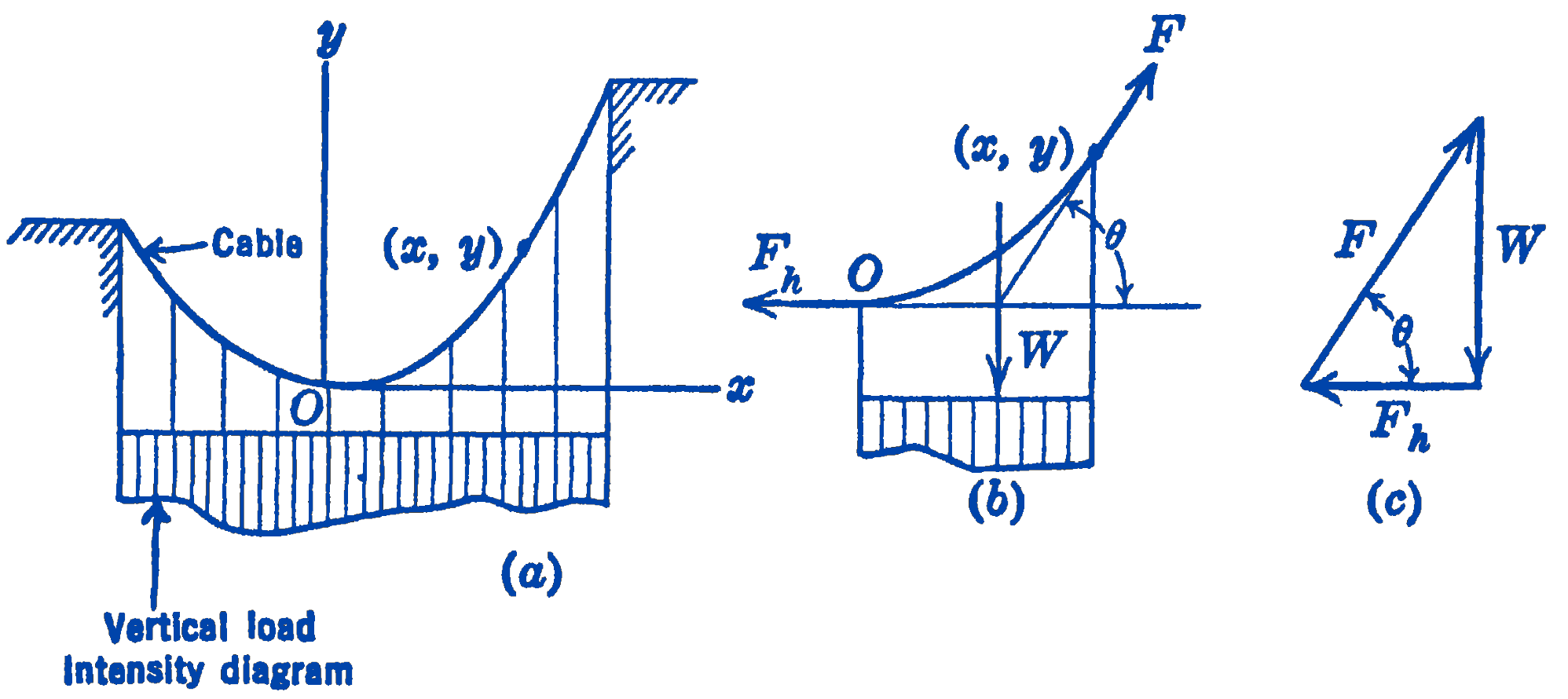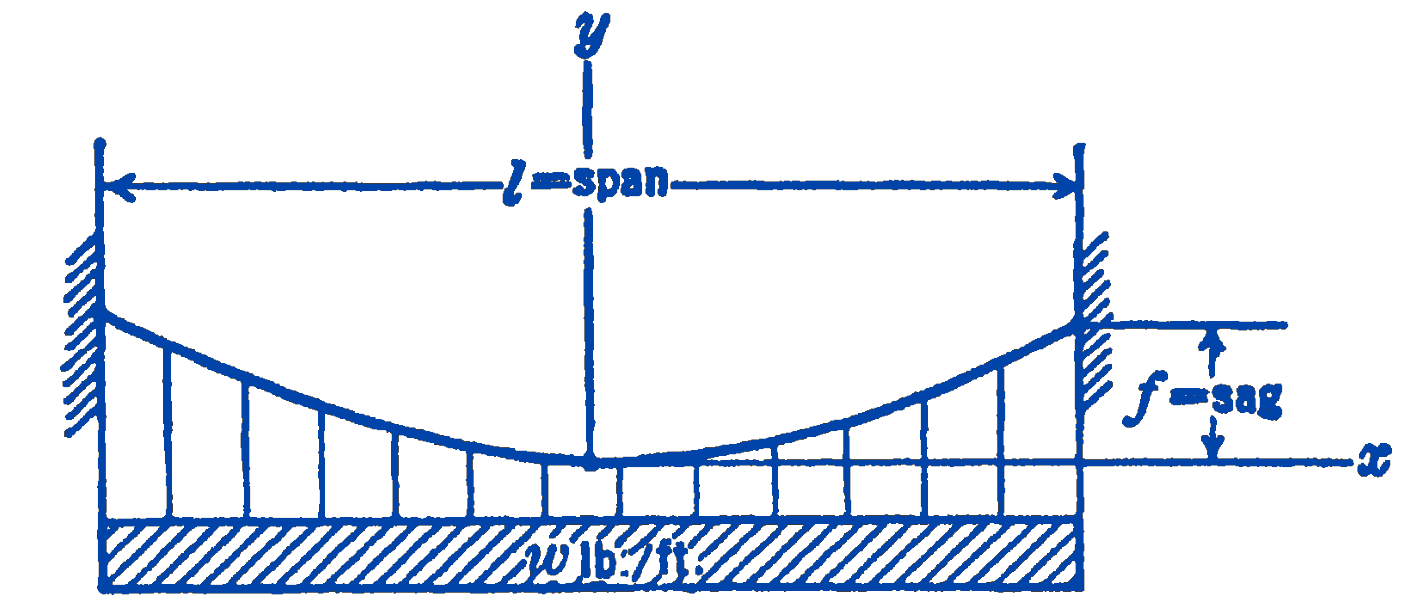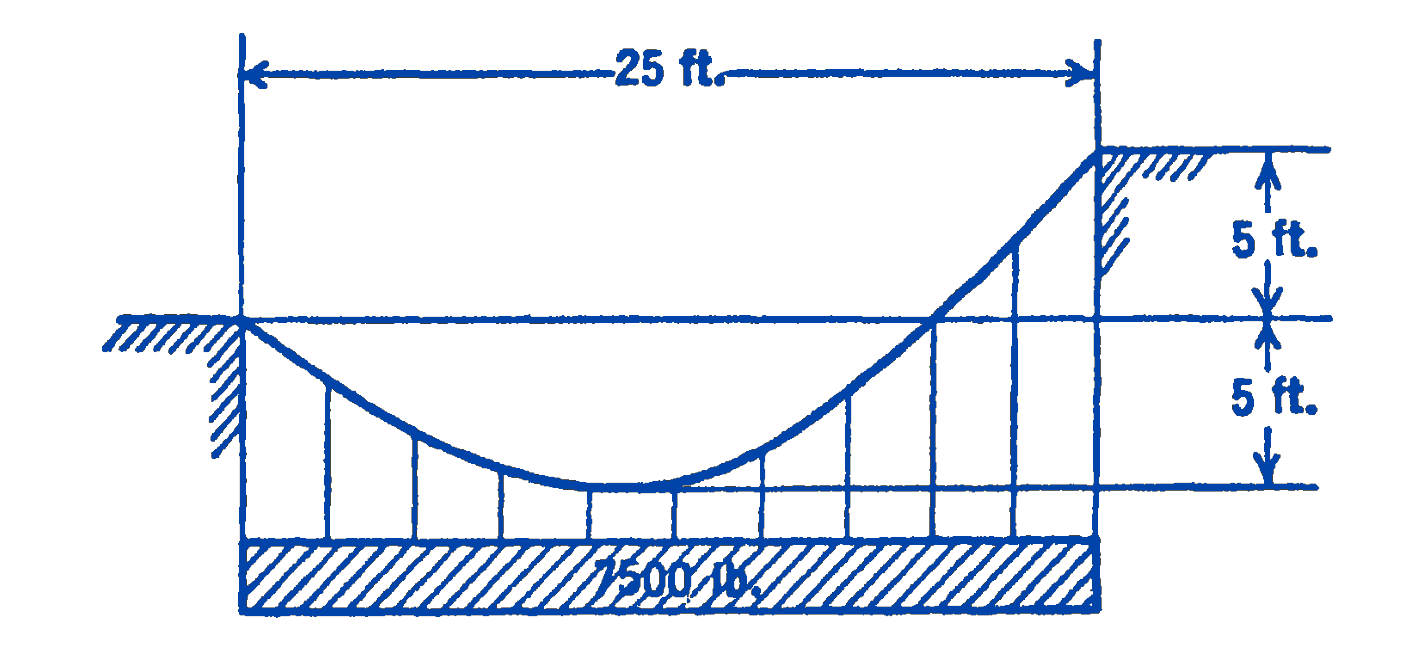
Suppose that a uniformly distributed load of intensity \(w\) lb per ft acts upon the cable. Then referring to the above figure, it will be seen that \(W=w x\), and the differential equation (see the previous section) becomes: \[ \frac{d y}{d x}=\frac{w x}{F_{h}} \] This equation can now be integrated to give: \[ y=\int \frac{w x}{F_{h}} d x+c=\frac{w x^{2}}{2 F_{h}}+c \] To find the constant of integration we note that for the coordinate system chosen \(y=0\) when \(x=0\) so that \(c=0\), then \[ \begin{equation*} y=\frac{w x^{2}}{2 F_{h}} \tag{1} \end{equation*} \] This is the equation of a parabola, so that we have shown that a flexible cable loaded by a uniformly distributed vertical load will assume a parabolic form.
From the force diagram of Fig. 1c we have: \[ F=\sqrt{F_{h}^{2}+W^{2}} \] so that for the uniform horizontal load \[ \begin{equation*} F=\sqrt{F_{h}^{2}+w^{2} x^{2}} \tag{2} \end{equation*} \] From this it appears that the horizontal force \(F_{h}\) at the lowest point in the cable is the smallest force in the cable, and that this force increases as \(x\) increases, becoming a maximum at the support.
In most practical problems we will know the span of the cable, i.e., the horizontal distance between supports, and we will wish to know the relationship between the maximum force in the cable and the vertical sag of the cable. We shall work out this relationship for the case in which the two ends of the cable are supported at the same level as in Fig. 2. Using the same coordinate system used in the development of Equation (1) above, we note that when \(x=\dfrac{l}{2}, y=f\), so that we have from Equation (1): \[ f=\frac{w\left(\dfrac{l}{2}\right)^{2}}{2 F_{h}} ; \quad F_{h}=\frac{w l^{2}}{8 f} \]

Then the maximum force in the cable, at the support, is found from Equation (2). \[ \begin{aligned} F_{\max } & =\sqrt{\left(\frac{w l^{2}}{8 f}\right)^{2}+w^{2}\left(\frac{l}{2}\right)^{2}} \\ & =\frac{w l}{2} \sqrt{1+\frac{l^{2}}{16 f^{2}}} \end{aligned} \]
Another relationship often required is that between the span \(l\), the total length \(S\) of the cable, and the sag \(f\). In the above cable the length would be: \[ \begin{gathered} S=2 \int_{0}^{\frac{l}{2}} dS=2 \int_{0}^{\frac{l}{2}} \sqrt{d x^{2}+d y^{2}}=2 \int_{0}^{\frac{l}{2}} \sqrt{1+\left(\frac{d y}{d x}\right)^{2}} d x \\ S=2 \int_{0}^{\frac{l}{2}} \sqrt{1+\frac{w^{2} x^{2}}{F_{h}^{2}}} d x \end{gathered} \] From the integral tables, we have: \[ \begin{aligned} S & =\left.\frac{F_{h}}{w}\left[\frac{w x}{F_{h}} \sqrt{1+\frac{w^{2} x^{2}}{F_{h}^{2}}}+\sinh ^{-1} \frac{w x}{F_{h}}\right]\right|_{0} ^{\frac{l}{2}} \\ & =\frac{l}{2} \sqrt{1+\left(\frac{w l}{2 F_{h}}\right)^{2}}+\frac{F_{h}}{w} \sinh ^{-1}\left(\frac{w l}{2 F_{h}}\right) \end{aligned} \]
In order to put this into a more convenient form for computation, let us expand each term in a series. The series expansions for these functions are:
\[ \begin{aligned} \sqrt{1+\left(\frac{w l}{2 F_{h}}\right)^{2}} & =1+\frac{1}{2}\left(\frac{w l}{2 F_{h}}\right)^{2}-\frac{1}{8}\left(\frac{w l}{2 F_{h}}\right)^{4}+\cdots \\ \sinh ^{-1}\left(\frac{w l}{2 F_{h}}\right) & =\left(\frac{w l}{2 F_{h}}\right)-\frac{1}{6}\left(\frac{w l}{2 F_{h}}\right)^{3}+\frac{3}{40}\left(\frac{w l}{2 F_{h}}\right)^{5}+\cdots \end{aligned} \]
Expressing these in terms of the “sag ratio” \(\left(\frac{f}{l}\right)\) we have: \[ F_{h}=\frac{w l^{2}}{8 f^{2}}, \text { so that }\left(\frac{w l}{2 F_{h}}\right)=4\left(\frac{f}{l}\right) \]
This ratio will ordinarily be sufficiently small so that the above series expansions will converge rapidly, and only the first few terms of the series need be retained. Thus: \[ \begin{aligned} S= & \frac{l}{2}+\frac{l}{4}\left(4 \frac{f}{l}\right)^{2}-\frac{l}{16}\left(4 \frac{f}{l}\right)^{4}+\cdots \\ & \quad+\frac{l}{2} \frac{1}{\left(4 \frac{f}{l}\right.}\left[\left(4 \frac{f}{l}\right)-\frac{1}{6}\left(4 \frac{f}{l}\right)^{3}+\frac{3}{40}\left(4 \frac{f}{l}\right)^{5}+\cdots\right] \\ = & \left(\frac{l}{2}+\frac{l}{2}\right)+\left(4 l-\frac{16}{12} l\right)\left(\frac{f}{l}\right)^{2}+\left(-\frac{256}{16}+\frac{768}{80}\right)\left(\frac{f}{l}\right)^{4}+\cdots \\ = & l\left[1+\frac{8}{3}\left(\frac{f}{l}\right)^{2}-\frac{32}{5}\left(\frac{f}{l}\right)^{4}+\cdots\right] \end{aligned} \]
From this expression the length of the cable can be determined when the span and sag are known.
6.14.1 PROBLEMS
1. The force in a cable which is suspended from two points 50 ft apart on the same level is to be limited to 10,000 lb. What is the maximum total load which the cable can support, if the load is uniformly distributed horizontally, and if the sag is 10 ft?
Answer
\(12,500 \ \mathrm{lb}\)
2. A cable 100 ft long is suspended from two points which are on the same level and which are 95 ft apart. If the cable supports a total load of 10,000 lb, uniformly distributed along the horizontal, what is the maximum force in the cable?
Answer
\(10,200 \ \mathrm{lb}\)
3. A uniformly distributed horizontal load of 7500 lb is supported by a cable as shown in the diagram. Find the maximum force in the cable.

Answer
5460 lb